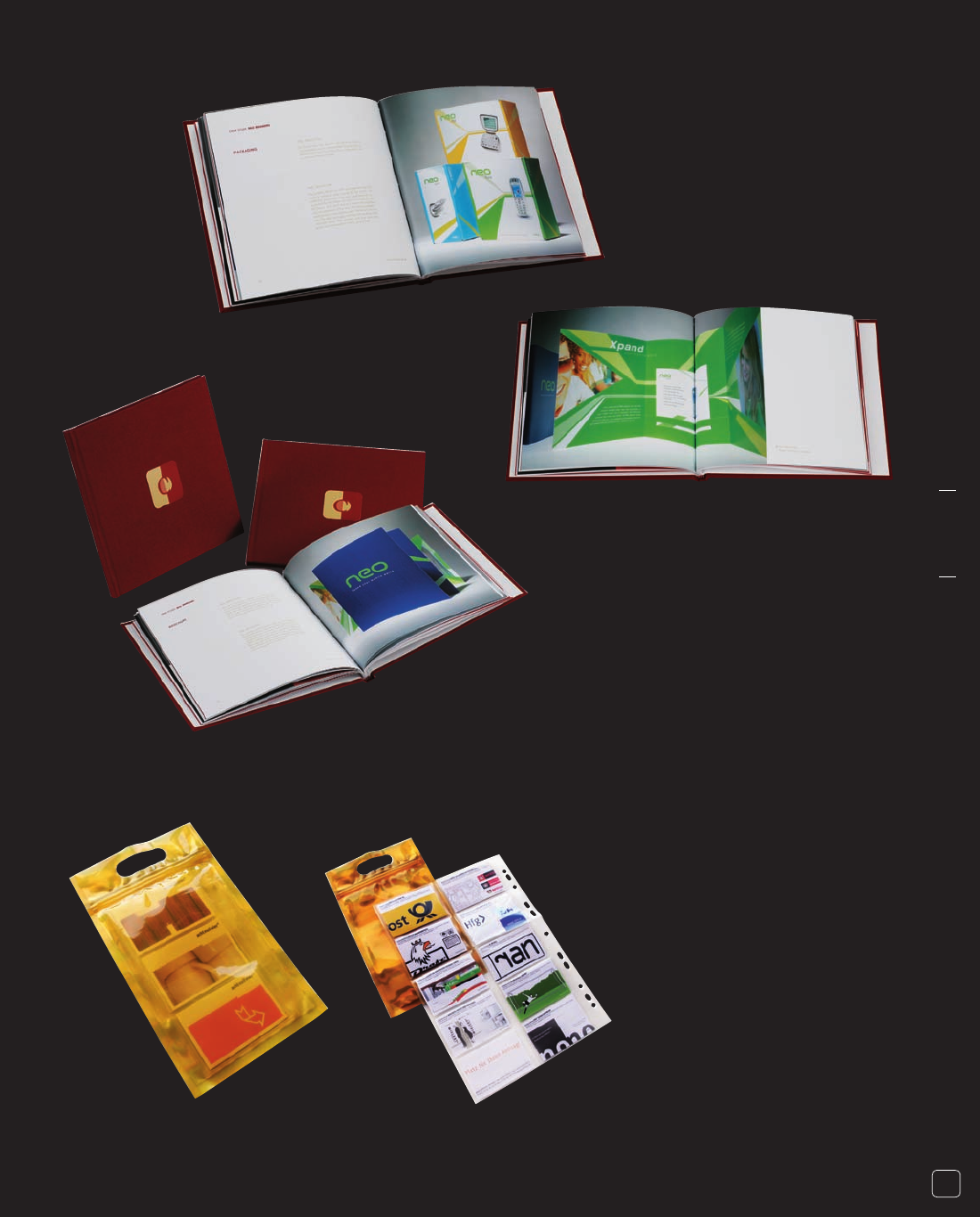
(RAY)
Job:11-15877/15287 Title:RP-Design Matters Portfolios
#175 P DTP:216 Page:36
001-093_15877.indd 36 11/30/09 3:19:32 PM
36
D E S I G N M AT T E R S / / P O R T F O L I O S 0 1
Text
P L A N N I N G
c r eat i n G i m p l e m e nt i n G
“I am just taking my first baby steps in graphic design, and since I already
want to apply for different jobs, I decided to use a blog temporarily to show my
humble portfolio pieces.”
“As with any portfolio, if you’re going to show your work, your blog needs to
look first class. Just like a website, don’t present it until the medium itself is a
portfolio piece.”
“I have an online portfolio. If requested, I send a PDF, which I also have on my
website. I have a book that I show when I get invited for an interview so that I
am able to speak about my body of work in person.”
“I’ve been a designer for five years, and I still have an 11 × 17-inch [28 ×
43 cm] book, but I also have my website, and other online profiles that allow
for a portfolio gallery.”
“My initial contact is always my website. Sometimes it’s email, sometimes phone,
and sometimes a self-promo, but always the website.”
“I am still using the same formula I have used since I graduated from art school
ten years ago: a traditional book on the smallish side [11 × 17 inches; 28 × 43
cm] and a PDF for emailing and online samples. I send the PDF most often. I
have never been asked for a leave-behind book nor have I mailed one to a client,
agency, or studio. I have gotten most jobs networking.”
“I have been in business for twelve years now (in-house and freelance), and the
way I refer to my work is via PDF, on my website, and with a custom book. When
I first started out, I had the standard black leather book with samples attached.”
“I have been a graphic designer for over twenty-three years. I originally used a
traditional book with vinyl pages, but now use a hard case with individual boards
and mounted images and a few hard copies of brochures, etc.”
“I’ve been practicing for over twenty-eight years. I used to drop off a physical
portfolio. Now I use only my website with downloads and direct mail support.”
For many creative professionals, how you format your portfolio is dependent on how long you’ve been in the creative
business and what you see as the best way to showcase who you are and what you do. Andrea Cutler, professor of design
at Parsons School of Design, asked a variety of colleagues and students, some of whom have been in the design industry
for decades and others who are “wet behind the ears,” how they format their portfolios. Here’s what they had to say:
out of the Mouths of those on the front lines of Design
(RAY)
Job:11-15877/15287 Title:RP-Design Matters Portfolios
#175 P DTP:216 Page:36
001-093_15877.indd 36 11/30/09 3:53:27 PM

Job:11-15877/15287 Title:RP-Design Matters Portfolios
#175 P DTP:216 Page:36
(RAY)
Job:11-15877/15287 Title:RP-Design Matters Portfolios
#175 P DTP:216 Page:37
001-093_15877.indd 37 11/30/09 3:19:45 PM
37
D E S I G N M AT T E R S / / P O R T F O L I O S 0 1
Text
P L A N N I N G
c r eat i n G i m p l e m e nt i n G
π√
“As a graphic designer whose expertise
is in print, it is important for me that
my portfolio reflects my abilities in this
discipline. Therefore, I chose to display
my design pieces in a book. I selected the
most outstanding case studies that I had
created in the past few years. The layout
is simple, clean, yet keeps the viewer
engaged, as there’s still a lot of movement
inside the spreads. The focus is always on
the images, whereas the text is used as a
complementary—and balancing—element.”
Carmit Haller
carmit d e S i G n (Belmont, c alifornia)
√
This self-promotional package of business
cards uses the small dimension to showcase
an intriguing miniature portfolio on the back
of each card. The extraordinarily colorful
packaging in the form of a little bag provides
the bling-bling needed to grab the viewer’s
attention.
804 Graphic d e S i G n
Job:11-15877/15287 Title:RP-Design Matters Portfolios
#175 P DTP:216 Page:36
(RAY)
Job:11-15877/15287 Title:RP-Design Matters Portfolios
#175 P DTP:216 Page:37
001-093_15877.indd 37 11/30/09 3:53:28 PM

(RAY)
Job:11-15877/15287 Title:RP-Design Matters Portfolios
#175 P DTP:216 Page:38
001-093_15877.indd 38 11/30/09 3:19:47 PM
38
D E S I G N M AT T E R S / / P O R T F O L I O S 0 1
Text
Portfolios and Brand
A SYM BIOTIC RELATIONSHIP
Many a provider of goods and services would like to do for their business what Starbucks has done for the coffee shop—
get the consumer or client to spend about three times what they used to spend. It is not that their coffee is so superior,
although it is very good. Rather, it’s their innovative marketing. Starbucks has transformed the ordinary task of getting
something to drink into a delightful experience. And it resonates throughout their brand.
Experts define brand as every
prospect or customer interaction with
your company that creates an impres-
sion. But a corporate or product brand
is clearly more than just a logo or an
advertisement—it’s the personality and
soul of a company. When it comes
to branding your portfolio, there are
some common mistakes to avoid:
• Inconsistent messages. A good
self-promotional campaign is de-
pendent upon consistency to build
trust and strength in a message.
For example, let’s say your port-
folio features an award-winning
website followed by an outdated
logo design for a company that’s
no longer in business. Having
such inconsistent design elements
featured in your portfolio can send
a wrong message about who you
are and where you’re taking your
company.
• Failure to differentiate. Creativity
is the key to differentiation.
And creating a unique position
for yourself and your company
provides a solid foundation for
your brand.
“Your brand is defined by other
people’s perceptions,” says Karl
Speak, president of Brand Toolbox,
an organization that helps companies
and individuals define their brand.
Speak is also the former chair of
the board of directors of the Design
Management Institute, a nonprofit,
global organization dedicated to
demonstrating the strategic role of
design in business and to improving
the management and utilization
of design. “Strong brands are
perceived to be distinctive, relevant,
and consistent. The most distinctive
brands are perceived to make the
biggest difference.”
For example, if you fail to distinguish
yourself at a trade show, by offering
a standard candy-dish-topped booth
display, you fail to give potential
customers a reason to select you
rather than the gal next door. Simply
put—make every meeting and event
memorable in the minds of your
audience. Have creative stand-alone
portfolio items that you can hand out
at a moment’s notice. Create surprise
and delight at every turn. That’s what
differentiation is all about.
P L A N N I N G c r eat i n G i m p l e m e nt i n G
(RAY)
Job:11-15877/15287 Title:RP-Design Matters Portfolios
#175 P DTP:216 Page:38
001-093_15877.indd 38 11/30/09 3:53:28 PM

Job:11-15877/15287 Title:RP-Design Matters Portfolios
#175 P DTP:216 Page:38
(RAY)
Job:11-15877/15287 Title:RP-Design Matters Portfolios
12-C54244 (204) #175 P DTP:216 Page:39
001-093_15877.indd 39 12/17/09 8:17:23 AM
D E S I G N M AT T E R S / / P O R T F O L I O S 0 1
39
Text
• Inconsistent, ineffective
identity. A brand is everything
from how your phone is
answered to the quality of your
customer service to the content
of your blog, not to mention your
company logo, office interior, and
marketing materials—it’s critical
that each of these elements
appropriately represent your
company’s identity. If one or more
of these elements is inconsistent
with the total message, you are
confusing your audience. Make
sure your identity is consistent.
A strong brand is the result of
good experiences, consistent
messages, and positive, reinforc-
ing images. “The process of
building a strong brand is to
define your brand platform and
deliver on your brand promise,”
Speak says.
P L A N N I N G c r eat i n G i m p l e m e nt i n G
Job:11-15877/15287 Title:RP-Design Matters Portfolios
#175 P DTP:216 Page:38
(RAY)
Job:11-15877/15287 Title:RP-Design Matters Portfolios
#175 P DTP:216 Page:39
001-093_15877.indd 39 11/30/09 3:53:28 PM

(RAY)
Job:11-15877/15287 Title:RP-Design Matters Portfolios
#175 P DTP:216 Page:40
001-093_15877.indd 40 11/30/09 3:20:0 PM
40
D E S I G N M AT T E R S / / P O R T F O L I O S 0 1
Text
π®
A strong level of brand consistency is
evident throughout Gerard Design’s portfolio
and self-promotional pieces. The “You’ll See”
piece was developed to support the agency’s
rebranding. Treating itself as a client, Gerard
Design took a research-based approach that
ultimately highlighted the need for sweeping
changes to the core facets of its brand,
including repositioning itself as a strategic
branding firm (not just design), refining
its messaging to clearly communicate the
agency’s capabilities, and creating a visual
identity that consistently supports Gerard
Design’s image and culture.
The “You’ll See” piece is a mini portfolio
targeted toward new and potential clients
to demonstrate the company’s branding
abilities. Using a coated paper highlights the
photography and images, which together
emphasize the company’s high-end work. In
other words, the firm lets the images do most
of the talking.
Gerard d e S i G n
P L A N N I N G c r eat i n G i m p l e m e nt i n G
(RAY)
Job:11-15877/15287 Title:RP-Design Matters Portfolios
#175 P DTP:216 Page:40
001-093_15877.indd 40 11/30/09 3:53:28 PM
..................Content has been hidden....................
You can't read the all page of ebook, please click here login for view all page.
